The Early Intervention Services Program provides, through direct operation or contractual agreements, preemptive, front-end services to youth, their families, and the community in a geographic area covered by the Second, Third, and Fourth Juvenile Court districts.
During the 2015 General Session, the Legislature appropriated for Fiscal Year 2016, $15,903,900 from all sources for Early Intervention Services. This is a 5.3 percent increase from Fiscal Year 2015 revised estimated amounts from all sources. The total includes $14,868,200 from the General/Education Funds, an increase of 6 percent from revised Fiscal Year 2015 estimates.
In addition to statewide compensation and internal service fund cost increases, the following appropriation adjustments were made during the 2015 General Session:
During the 2013 General Session, the Legislature appropriated $1.25 million in General Fund ongoing money to continue operation of the Genesis Work program. This $1.25 million is a part of the $14.2 million General Fund appropriation in the FY 2014 Approp column below.
The $2.0 million increase in General Fund appropriations from FY 2013 to FY 2014 is a result of the shift of oversight of Observation and Assessment Centers along the Wasatch Front from the Office of Community Programs to the Office of Early Intervention Services in FY 2013.
Percent of youth completing the program without a new felony charge within 90 days
Diversion Services
- Percent of Youth Completing the Program without a New Felony Charge within 90 Days. This measure identifies youth recidivism after program completion. This measures the program's ability to suppress youths further penetration into the juvenile justice system and to keep the community safe from more serious offenses.
FY 2013 Results:
Total Admissions: 1,193 Different Youth Served: 1,044 Males Admitted: 882 Females Admitted: 311 Average Length of Stay: 29 Days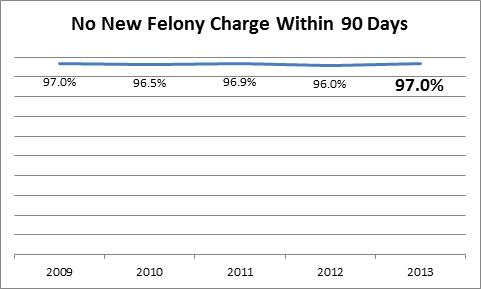
- Percent of Youth Completing the Program without a New Felony or Misdemeanor Charge within 90 Days. This measure identifies youth recidivism after program completion. This measures the program's ability to suppress youths' further penetration into the juvenile justice system and to keep the community safe from any type of offense.
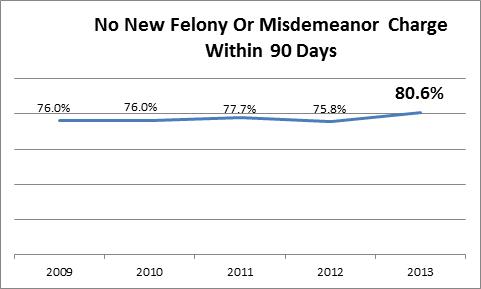
- Percent of Youth with a Negative Drug Test at Program End. This measure identifies the program's ability to suppress youths' delinquency and avoid further penetration into the juvenile justice system.
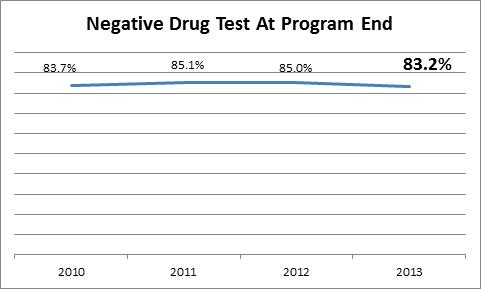
- Percent of Youth Who Complete the Program. This measures the program's ability to successfully divert youth from more restrictive and costly detention facilities.
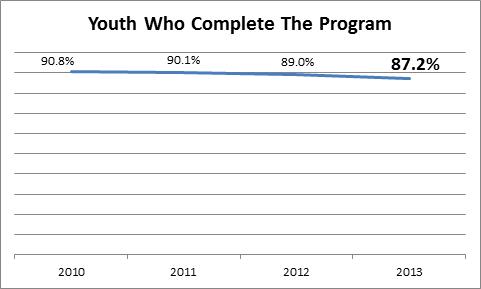
Percent of youth released to a parent or adult guardian
Receiving Centers
- Percent of Youth Released to a Parent or Guardian. Receiving centers strive to reunite youth with their parents or adult guardians and to aid the family in obtaining community resources available to address offending issues. The measure identifies the program's ability to successfully do this. (Note: Not included in the graph data are youth admitted to crisis residential and later released to a parent or guardian, rather than being released directly to a parent or guardian from receiving centers).
FY 2013 Results:
Total Admissions: 3,390 Males Admitted: 2,038 Females Admitted: 1,352 Different Youth Served: 2,561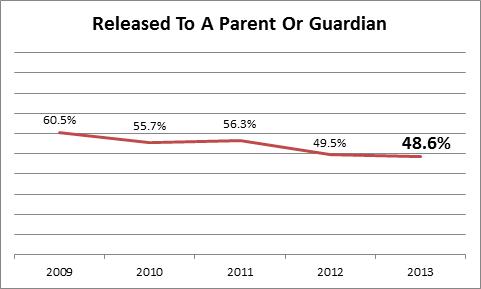
- Percent of Law Enforcement Who Return to Duty within 20 Minutes after Bringing a Youth to the Center. Local law enforcement officers place status offending youth in receiving centers, thus allowing the officers to quickly return to their duties in the community. This measure identifies how successful the program meets the local law enforcement officers need to return to their regular duties.
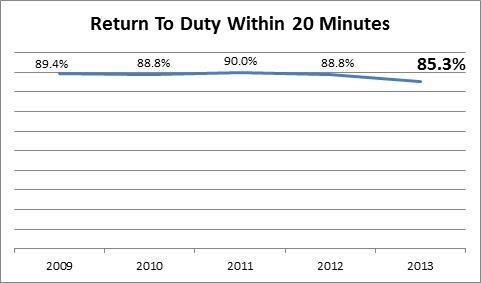
Percent of youth where assessment disposition recommendations are followed by the Court
Observation and Assessment [O&A]
- Percent of Youth Where the Assessment Disposition Recommendations are followed by the Court. After assessments are completed, the staff use the gathered information to make recommendations to the courts as to the best placement for the youths. This measures the staff's ability to make appropriate recommendations and to articulate those effectively to the courts.
FY 2013 Results:
Total Admissions: 576 Different Youth Served: 624 Males Admitted: 419 Females Admitted: 157 Average Length of Stay: 43.3 Days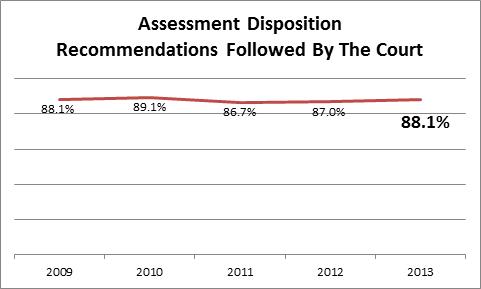
- Percent of O&A Reports Submitted to the Court within 48 Hours of the Court Hearing. This measures the staff's responsiveness to submit information to the courts for their proceedings.
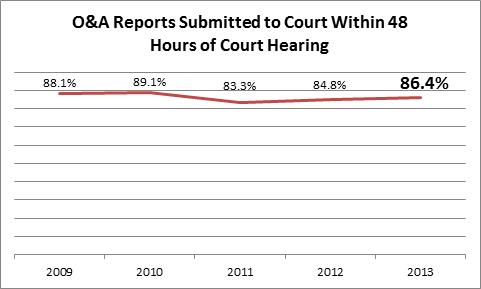
Percent of youth who avoid a new disposition for DCFS custody, DJJS custody, or juvenile court within 90 days of release
Youth Services
- Percent of Youth Who Avoid Receiving a New Disposition for DCFS Custody, DJJS Custody, or Juvenile Court within 90 Days of Release From Youth Services. This measure identifies how the services and referrals provided by Youth Services deter youth from further need of State services.
FY 2013 Results: 97.3%
Crisis Results:
- Total Admissions: 1,168
- Different Youth Served: 771
- Males Admitted: 652
- Females Admitted: 516
60 Day Counseling Results:
- Total Admissions: 583
- Different Youth Served: 557
- Males Admitted: 296
- Females Admitted: 287
- Average Length of Stay: 64.1 Days
Group Home Results:
- Total Admissions: 2,842
- Different Youth Served: 2,069
- Males Admitted: 1,604
- Females Admitted: 1,238
- Average Length of Stay: 2.7 Days
Percent of youth without a new felony charge within 90 days of release
Genesis Work Program
- Percent of Youth without a New Felony Charge within 90 Days of Release. This measure identifies youth recidivism after program completion. This measures the program's ability to suppress youths' further penetration into the juvenile justice system and to keep the community safe from more serious offenses.
FY 2013 Results:
Total Admissions: 213 Different Youth Served: 238 Males Admitted: 152 Females Admitted: 61 Average Length of Stay: 58 Days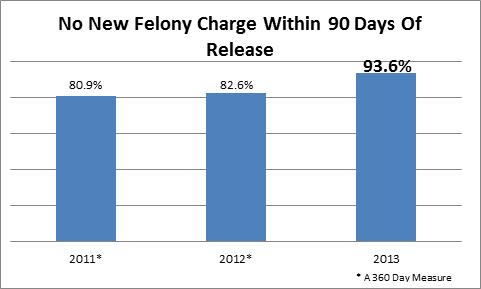
- Percent of Youth without a New Felony or Misdemeanor Charge within 90 Days of Release. This measure identifies youth recidivism after program completion. This measures the program's ability to suppress youths' further penetration into the juvenile justice system and to keep the community safe from any type of offense.
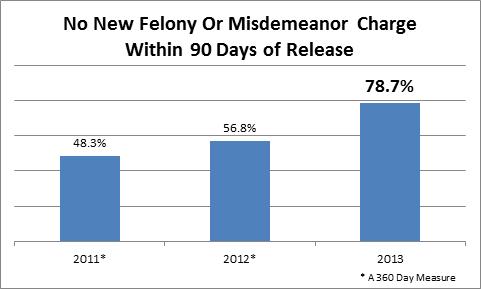
- Percent of Youth Who Complete at Least 85% of Their Court-Ordered Restitution and Community Service While in the Program. The Genesis program provides a vehicle for youth to meet their court-ordered obligations. This measures the program's ability to have youth complete those obligations.
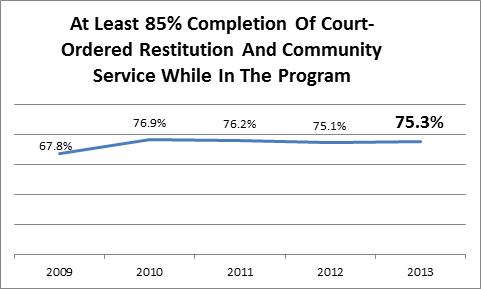
Top indicators of success in Early Intervention Services
The program has identified the top performance measures it uses to monitor success in each of its focus areas. Greater detail is provided for each focus area below.
The program manages:
- Receiving Centers. Non-residential facilities where law enforcement officers can take youth who have been arrested but do not meet the admission guidelines for detention. The staff locates parents or guardians which frees law enforcement to return to normal duties. Staff members assess the youth to determine if other interventions may be of benefit, and notify parents of resources available in the community.
- Youth Services. Provides 24-hour crisis counseling services to runaway and ungovernable youth and their families. Services attempt to keep families intact and commit resources, but short of a full intervention into the Juvenile Justice System. Services also include short-term crisis beds. These services are typically housed and provided in receiving centers located throughout the state.
- Home Detention. Provides an alternative to secure detention for youth awaiting adjudication or placement. Youth are home in the community with daily supervision provided by qualified staff.
- Diversion Services. Short-term (30 day) treatment services to non-DJJS custodial youth referred by the Juvenile Court. Programming includes intensive daily supervision, competency development, and community service/restitution.
- Genesis Youth Center. This work program provides the opportunity for youth offenders to provide restitution to victims. Services help to maintain and operate public agencies and non-profit programs. The center also provides education and prevocational programs.
- Observation and Assessment Centers. This 45-day program allows the division to prepare a comprehensive evaluation and treatment plan for custody youth. Resulting recommendations to the Juvenile Court facilitate future treatments and placements. Psychological, behavioral, social, educational, and physical assessments, evaluations, and observations are utilized.
COBI contains unaudited data as presented to the Legislature by state agencies at the time of publication. For audited financial data see the State of Utah's Comprehensive Annual Financial Reports.